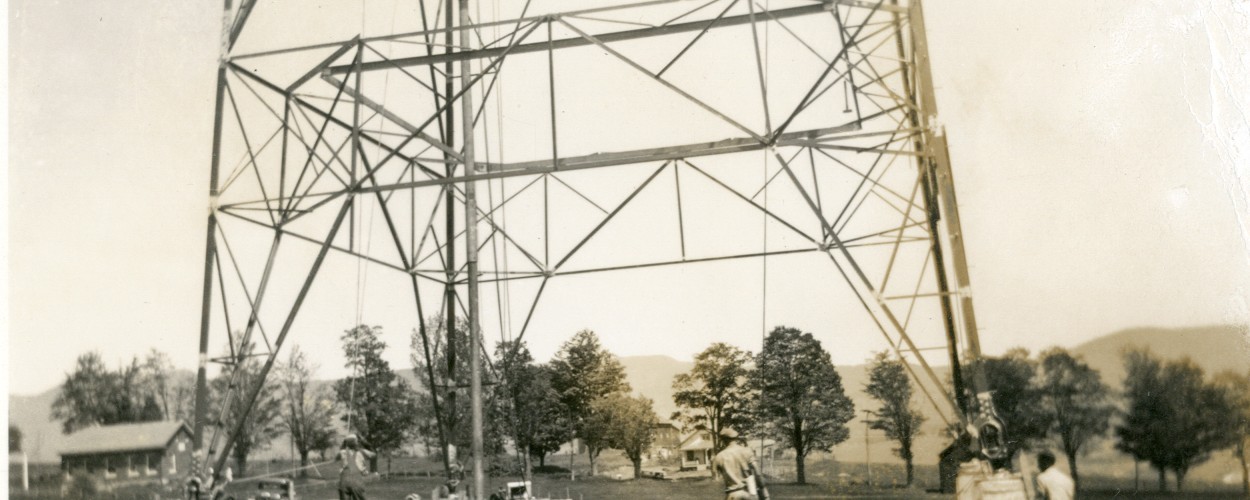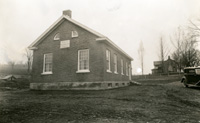Early Days of Radio, 1920

Oral history transcriptions
Click a name below for more information. All transcripts are in PDF format.
Background information
 The start of radio broadcasting in the United States is generally traced to 1910, when a program was produced from the Metropolitan Opera House in New York City. The United States government banned non-government radios during World War I, but after military restrictions were relaxed following the war, many experimental radio stations went on the air. An experimental station was established at the University of Wisconsin in 1915, and another began at Pittsburgh in 1916. The first commercial radio station was KDKA in Pittsburgh, which went on the air on November 2, 1920, broadcasting the returns of the Harding-Cox presidential election.
The start of radio broadcasting in the United States is generally traced to 1910, when a program was produced from the Metropolitan Opera House in New York City. The United States government banned non-government radios during World War I, but after military restrictions were relaxed following the war, many experimental radio stations went on the air. An experimental station was established at the University of Wisconsin in 1915, and another began at Pittsburgh in 1916. The first commercial radio station was KDKA in Pittsburgh, which went on the air on November 2, 1920, broadcasting the returns of the Harding-Cox presidential election.
The first radio broadcast from a Vermont location originated at the University of Vermont’s station WCAX on October 10, 1924. The station was the outgrowth of a vigorous campus interest in radio in 1919, stimulated by the return to the university of several students with World War I experience as radio operators. In the summer of 1924, the Extension Service of the Agricultural College decided to build a broadcast station. Sophomore student William M. Hall was asked to undertake the building and assembly of the station. Hall recalled later that for assistance in the project he relied heavily on the university’s electrical engineering department, the local Sherwin Electric Company, and Paul Chamberlain of the E. E. Clarkson Company in Burlington. He also consulted a manual, Radio Telephony for Amateurs.
The new station was housed in a temporary building behind the University of Vermont’s Williams Science Hall, where it shared space with two classrooms, an electric machine laboratory, and the student Radio Club. A pot bellied stove heated the facility and draperies were hung to improve the acoustics for use of the space as a studio.
To support the station’s 160 foot antenna, Hall erected an 85-foot steel tower made from a windmill tower and a twenty-foot pipe extension. Assistance in its construction was provided by G. S Blodgett Company of Burlington. The other end of the antenna was anchored on a forty-five foot wooden pole, which was already in use as a support for the amateur station’s antenna, located at the east end of the building. Much of the needed equipment was not available from catalogs and had to be hand made; for this task Hall acquired the use of the machine shops in the Engineering Building.
Several members of the university Radio Club provided help in setting up and operating the station. They had acquired commercial operator’s licenses by taking an examination from a government radio inspector who had been in Burlington the previous winter. Hall tested the station’s signal during the summer of 1924 and managed to receive reports from as far away as Pennsylvania, New Jersey, and Michigan. He recalled, “We knew that these reports did not guarantee solid coverage of the entire State of Vermont, but we had high hopes for success.” The stations’ transmitter was rated at 100 watts, transmitting at a frequency of 1200 kilocycles.
When the station finally was ready for regular broadcasts, a schedule of weekly programs was established. On October 8, 1924, the Burlington Free Press published an announcement of a new “weekly educational and entertainment service...furnished by the Extension Service in co-operation with the several instructional and research departments of the University for radio owners in Vermont and neighboring territory.”
The first broadcast, two days later, featured brief addresses by several University of Vermont administrators, including President Guy W. Bailey. The R.O.T.C. band furnished music. The Free Press reported that future weekly programs would include educational talks, agricultural talks, health talks, literary talks, and pure entertainment talks. Concerts by the University band, the Men’s and Women’s Glee Clubs, and by stringed instrument organizations would likewise be offered. Individual talent from the student body, as well as from the faculty, notable musicians and readers, would add to the programs. Whenever possible, the programs of outside artists who were presenting entertainment in Burlington would be broadcast. College players, reports of games, fraternity stunts, would constitute features. The Agricultural Extension Service would render timely service regularly to its farmer constituency and immediate service in case of emergency.
By running telephone lines to the gymnasium and to the Old Mill Building, the station was able to broadcast basketball games and a Sunday afternoon recital. Hall recalled that “An attempt to broadcast a baseball game from Centennial Field, relaying the comments by word of mouth because we could not connect a private line directly to the transmitter, proved a total flop.”
After the university had operated the station for seven years, it was acquired by the Burlington Daily News on November 4, 1931, and became a commercial station. A new 125-foot tower was installed in 1931, and its power was increased to 250 watts in 1937. IN the same year a 250-foot tower was located on the Daily News property in downtown Burlington. In 1941, the station’s power was increased to 1 kilowatt, and in 1947, to 5 kilowatts. The Daily News and the radio station were purchased by Charles Hasbrook in 1938, and the newspaper eventually was sold again, separating the radio station from it. In 1940, WCAX became the Vermont outlet for CBS, and in 1954, the television station WCAX was added. In 1963 the radio broadcast station WCAX was sold and renamed WVMT.
—Gene Sessions
Further reading
William M. Hall, “Radio Broadcasting Comes to Vermont: WCAX, the University of Vermont Radio Station,” Vermont History 49 (Spring 1981): 92-96.
J. Ralph Spalding, “Radio Work at the University of Vermont,” The Vermonter 27 (1922): 40-41.
Citation for this page
Woodsmoke Productions and Vermont Historical Society, “Early Days of Radio, 1920,” The Green Mountain Chronicles radio broadcast and background information, original broadcast 1988-89. https://vermonthistory.org./early-days-of-radio-1920